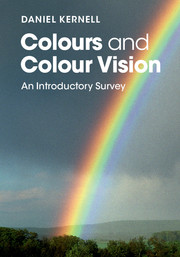Book contents
- Frontmatter
- Dedication
- Contents
- List of plates
- List of figures
- List of tables
- Preface
- 1 Colour vision in everyday life
- 2 The signals of colours: light and wavelengths
- 3 Colours and viewing conditions: not only local wavelengths
- 4 Our biological hardware: eye and brain
- 5 Eyes with unconventional properties: the ‘red-green blinds’
- 6 Other kinds of unconventional colour vision
- 7 Colour vision in different species of animals
- Appendices
- Appendix A Diagnosis and measurement of differences in colour vision
- Appendix B Specification and measurement of colours
- Appendix C Light and lighting
- Appendix D Digital cameras
- Appendix E Technical terms
- Notes
- References
- Index
- Plate section
Appendix B - Specification and measurement of colours
from Appendices
Published online by Cambridge University Press: 05 March 2016
- Frontmatter
- Dedication
- Contents
- List of plates
- List of figures
- List of tables
- Preface
- 1 Colour vision in everyday life
- 2 The signals of colours: light and wavelengths
- 3 Colours and viewing conditions: not only local wavelengths
- 4 Our biological hardware: eye and brain
- 5 Eyes with unconventional properties: the ‘red-green blinds’
- 6 Other kinds of unconventional colour vision
- 7 Colour vision in different species of animals
- Appendices
- Appendix A Diagnosis and measurement of differences in colour vision
- Appendix B Specification and measurement of colours
- Appendix C Light and lighting
- Appendix D Digital cameras
- Appendix E Technical terms
- Notes
- References
- Index
- Plate section
Summary
More or less quantitative coloristic specifications are important in many branches of industry, controlling whether various fabricated items have the specified and/or required colour. Such determinations might concern, for instance, consumer articles like food, cosmetics, textiles, clothes, furniture, car seats, etc. There are at least three alternative procedures for the specification of colours: (1) direct comparisons to samples from various kinds of colour charts; (2) measurements using a (tri-stimulus) colorimeter; (3) measurements using a spectrophotometer.
Colour charts and systems
In the first chapter of this book, I dealt with the rather limited everyday vocabulary used for describing the confusing multitude of possible colours (Sections 1.1, 1.2; Plate 1.2). However, it is sometimes necessary to be able to use a more differentiated terminology for defining precisely which colours one sees or wants to see. As a basis for such definitions, the colours need somehow to be ordered into a system.
From ancient times, various philosophers and scientists have tried to analyse how all the many colours arise and how they are linked and interacting. In the course of history, hundreds of such surveys have been assembled; more than 160 schemes of this kind were summarized and reviewed in a recently published book. Such lists and overviews have been made with different main purposes in mind:
Analytical surveys: colours ordered in relation to scientific findings concerning the physical/physiological basis for colour differences. This includes the systematic ordering of colours as seen in the solar spectrum (Plates 2.1b, 2.4), often arranged in circles with complementary colours opposite to each other (Plates 2.1c, 3.4b, 3.5b). Such analytical schemes form the basis for many of the more practically oriented surveys.
Practical surveys: lists and schemes providing easily used definitions for great numbers of different colours (Section B.1.1).
Measurement schemes: quantitative systems for the graphical analysis and summary of measured colour parameters (Section B.1.2).
These various strategies are not mutually exclusive, and several colour maps have been made with more than one of these purposes in mind. Besides systematic surveys of the kinds 1–3, there are also other kinds of summaries in which colours are ordered according to various aesthetic, emotional or other subjective/introspective aspects. Examples of such popular summaries are continually published in great numbers of books and articles, e.g. concerning clothes, gardens, home decoration, religion and spirituality, etc.
- Type
- Chapter
- Information
- Colours and Colour VisionAn Introductory Survey, pp. 204 - 213Publisher: Cambridge University PressPrint publication year: 2016



